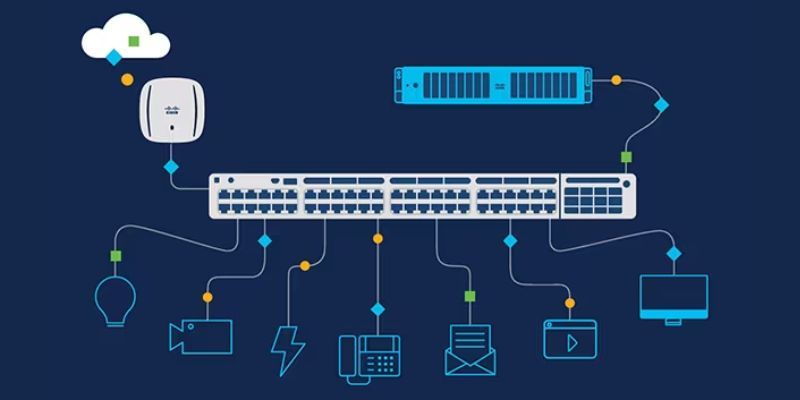
Understanding the various network devices is crucial for effective network management and security. These devices can be loosely categorised based on the ISO layer at which they function and their introduction timeline. Familiarity with these examples can facilitate the creation of a modern, secure, and dependable network. Here is an overview of some of the key network devices:
In the realm of the CCNA Course in Chennai, individuals often delve into the intricacies of networking with a focus on the Hub (Physical Layer). Introduced in the early stages of networking, a hub is a simple device that connects multiple computers in a network. It operates at the physical layer and broadcasts data to all devices connected to it.
the Switch (Data Link Layer) becomes a pivotal component. It is a more advanced and efficient version of a bridge, operating at the data link layer. This intelligent device transmits data only to the intended recipient by learning the MAC addresses of connected devices.
understanding the nuances of network devices like the Wireless Access Point (WAP) (Physical Layer/Data Link Layer) is imperative. A WAP enables wireless devices to connect to a wired network using Wi-Fi, operating at the physical and data link layers, providing wireless connectivity within its range.
Network devices: Definition and significance in networking
A network device, whether hardware or software, plays a crucial role in facilitating communication between a computer and an internet network. These devices serve two primary roles. The first role involves establishing a network connection, as exemplified by routers or modems. The second role is centered around maintaining, protecting, and enhancing the established connection, as demonstrated by devices such as hubs, repeaters, switches, or gateways.
Delving into the world of cybersecurity through a Cyber Security Course in Bangalore, professionals often encounter the Firewall (Network Layer/Transport Layer). This critical component acts as a security device, monitoring and controlling incoming and outgoing network traffic based on predetermined security rules. It operates at the network layer or the transport layer, ensuring network security and safeguarding against unauthorized access.
Functions of network devices
Networking devices fulfill several essential purposes, including:
- Facilitating smooth data transmission and communication between various devices.
- Enabling efficient and secure network connectivity for seamless operations.
- Enhancing network performance and optimizing the flow of traffic for improved efficiency.
- Providing network security through access control and proactive threat prevention measures.
- Simplifying network management and configuration for streamlined operations.
- Extending network coverage and overcoming signal limitations for comprehensive connectivity.
Types of network devices
The most important two network devices are
- Network interface cards (NICs)
- Wireless access points (WAPs)
Network interface cards (NICs)
For those aspiring to pursue a CCNA course in Bangalore, A Network Interface Card (NIC) is a vital hardware component that allows a computing device to connect to a network. It functions by enabling the transmission and reception of data packets between the device and the network. NICs play a critical role in establishing connectivity and facilitating seamless data transfer within a network.
NICs can be broadly classified into two main types:
- Ethernet NICs: These NICs typically utilise an 8P8C socket to establish a wired connection to an Ethernet network. They are commonly used in desktop computers, servers, and other devices that require a stable and high-speed wired connection.
- Wi-Fi NICs: These NICs enable devices to connect to wireless networks, providing users with the flexibility to access the network without the need for physical cables. Wi-Fi NICs are commonly found in laptops, tablets, and mobile devices, allowing users to connect to wireless networks and access the internet on the go.
The presence of a functional NIC is crucial for enabling seamless network communication and ensuring reliable data transmission between devices and the network.
Wireless access points (WAPs)
A Wireless Access Point (WAP) is a crucial device used to establish a wireless local area network (WLAN). It serves as a central communication hub that enables wireless devices to connect to a wired network through radio signals. WAPs play a vital role in expanding network coverage and providing wireless connectivity to various devices within a specific area.
Key features and functions of a Wireless Access Point include:
- Transceiver Device: A WAP consists of a transceiver that facilitates the transmission and reception of wireless signals, allowing wireless devices to communicate with each other and access the network.
- WLAN Creation: WAPs are designed to create and manage WLANs, providing users with wireless connectivity and enabling seamless data transfer within the network.
- Network Expansion: By connecting to a wired Ethernet LAN, WAPs allow for the expansion of the network, accommodating additional clients and enhancing overall network capacity.
- Transmission Range: The effectiveness of a WAP is dependent on its transmission range, which determines the maximum distance at which wireless devices can establish a reliable connection and access network resources.
- Antenna Capability: High-quality WAPs are equipped with powerful antennas that extend the reach of the wireless signal, enabling broader coverage and enhancing signal strength in various environments.
- Network Infrastructure Support: WAPs facilitate the integration of wireless and wired networks, enabling seamless communication between devices and providing users with access to network resources.
For those passionate about ethical hacking and enrolled in an Ethical Hacking Course in Chennai, the deployment of multiple WAPs can be necessary to ensure comprehensive network coverage, especially in large-scale environments or areas with numerous obstructions. Overall, WAPs are essential components in establishing the reliable and efficient wireless connectivity for various network devices and users.